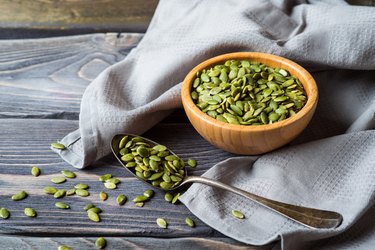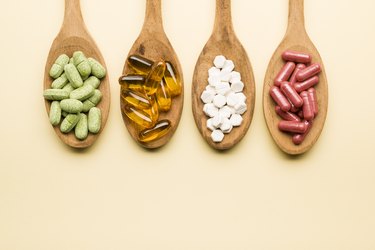
Whether you eat them whole or extract them from their pulpy web, pumpkin seeds are full of protein, fiber and important minerals, per the Mayo Clinic. But while pumpkin seeds offer health and nutritional benefits — and are a tasty, crunchy add-in to salads and trail mix — they can also be a source of some undesirable side effects.
Here's what you need to know about the potential side effects of eating pumpkin seeds, along with how to ward off these GI-related effects.
Video of the Day
Video of the Day
1. Pumpkin Seeds Can Leave You Gassy or Bloated
Pumpkin seeds are a great source of fiber, with 0.9 grams of fiber per one-ounce serving of shelled seeds, according to the USDA. Eating the same amount of pumpkin seeds in the shell means even more fiber, with 2 grams, per the USDA.
And that fiber delivers many benefits, such as keeping you regular, lowering cholesterol, helping you get to a healthy weight and controlling blood sugar, per the Mayo Clinic. But eating high-fiber foods can also cause indigestion, per the U.S. National Library of Medicine (NLM). That is, you may feel bloated, gassy and flatulent and generally experience GI discomfort after having a handful (or several) of high-fiber pumpkin seeds.
Here's why: Fiber is a type of carbohydrate that isn't fully digestible by your body. Unlike other carbs (think: rice, flour and so on), fiber doesn't break down into glucose, according to the Harvard T.H. Chan School of Publishing. Instead, the undigested fiber travels to your large intestine, where it's broken down by bacteria, with various gasses released as part of that process, per Cedars-Sinai.
2. They Can Lead to Diarrhea
Eating more fiber than you're used to can also lead to loose, watery stools aka diarrhea, according to the Canadian Society of Intestinal Research.
This may feel confusing, since fiber is often recommended as a fix for diarrhea. (Here are the best fiber supplements for diarrhea.) But as it turns out, not all fiber has the same effect on your body.
There are two broad categories of fiber: soluble (which dissolves in water, forming a gel-like substance) and insoluble, which does not, per the Mayo Clinic. Seeds tend to have insoluble fiber, per the University of California San Francisco (UCSF) Health. But if you have diarrhea, you'll want to focus on adding soluble fiber, not insoluble fiber, according to the Canadian Society of Intestinal Research.
That said, most plant-foods have a mix of both types of fiber.
Pumpkin Seeds Can Also Cause Constipation
Constipation is also a possible side effect of eating pumpkin seeds — just as a lot of fiber can lead to loose stools, it can also have the reverse effect, and stop you up temporarily, per the Cleveland Clinic.
As with diarrhea, fiber can both cause the problem, and act as a potential useful solution.
You Can Take in More Salt and Calories Than Intended
While eating pumpkin seeds, it's easy to lose track of how much you're eating.
This could lead to you unintentionally consuming more calories than you realize — a one-ounce serving size of shelled pumpkin seeds has 151 calories, per the USDA. Store-bought roasted pumpkin seeds can also have a lot of salt, according to the American Heart Association. One brand of shelled pumpkin seeds, for instance, has 104 mg of sodium.
Aim to get unsalted or lightly salted options — or make your own! Keep in mind that you can eat the pumpkin seed shell, although you might find the texture off-putting. Plus, that's where a big share of the fiber is, so overdoing it on the shell could lead to some GI symptoms.
How to Prevent Side Effects From Pumpkin Seeds
Fortunately, when it comes to fiber-filled pumpkin seeds, the ways to avoid these GI-related symptoms are simple:
- Eat seeds in moderation: Adding too much fiber, too fast, to your diet can lead to digestive woes. Incorporate pumpkin seeds — and other high-fiber foods — to your diet over the course of weeks to help avoid gas and bloating, per the Mayo Clinic. A typical serving size for seeds is an ounce (or about 1/4 cup).
- Discard the shell: Since the shells are a big source of fiber, you can remove them to reduce your fiber intake.
- Drink water, too: If you're upping your fiber intake, make sure to add water as well to ward off constipation, according to the Canadian Society of Intestinal Research.
How to Store Pumpkin Seeds
Because of their oil content, seeds can spoil quickly. Store them in a cool and dry place if you'll be eating them soon — for a longer lifespan, keep seeds in freezer or refrigerator, according to the California Department of Social Services.
Seeds that smell musty, oily or grassy have probably gone rancid and should be discarded.
- Mayo Clinic: "Pumpkin: Loaded with scary-good nutrients"
- U.S. National Library of Medicine: "Indigestion"
- Mayo Clinic: "Dietary fiber: essential for a healthy diet"
- Harvard T.H. Chan School of Publishing: "Fiber"
- USDA: "Waymouth Farms Inc. - Shelled Pumpkin Seeds"
- Ceders-Sinai: "Gas in the Digestive Tract"
- Canadian Society of Intestinal Research: "Diarrhea and Diet"
- USDA: "Lunds Inc - Pumpkin Seeds In Shell"
- Cleveland Clinic: "Improving Your Health With Fiber"
- American Heart Association: "Pumpkin seeds pack a healthy punch"
- University of California San Francisco Health: "Increasing Fiber Intake"
- Canadian Society of Intestinal Research: "Dietary Fibre"
- California Department of Social Services: "Nuts & Seeds"





